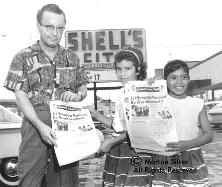
"Russella Tiger, left,... is the daughter of
Howard Tiger, president of the board of directors of the Seminole Tribe of Florida, Inc....
Scarlet Marie Jumper, right, is the daughter of Seminole Indian News editor
Betty Mae Jumper."

"Congratulations From Metropolitan Dade County and the City of
Miami To The Seminole Indian News
On Their First Edition. Best Wishes For Future Success."
Seminole Indian News,
Aug, 10, 1961, Vol.1,
No.1, p.2
The following quotes are
taken from Sept. 1961
Vol.1 No.2 P.2
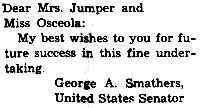
George A. Smathers,
U.S. Senator
"Dear Mrs. Jumper and Miss
Osceola:
My best wishes to you for future success in this fine undertaking."
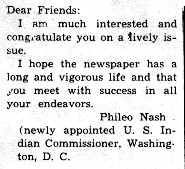
Phileo Nash, U.S. Indian Commissioner, Washington,
D.C.
"Dear Friends:
I am much interested and congratulate you on a lively issue.
I hope the newspaper has a long and vigorous life and that you meet with
success in all your endeavors."
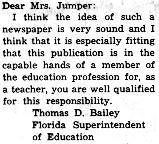
Thomas D. Bailey, Florida Superintendent of
Education
"Dear Mrs. Jumper:
I think the idea of such a newspaper is very sound and I think that it is
especially fitting that this publication is in the capable hands of a member of the
education profession for, as a teacher, you are well qualified for this
responsibility."
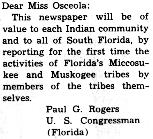
Paul G. Rogers, U.S. Congressman (Florida)
Dear Miss Osceola:
"This newspaper will be of value to each Indian community
and to all of South Florida, by reporting for the first time the activities of Florida's
Miccosukee and Muskogee tribes by members of the tribes themselves."
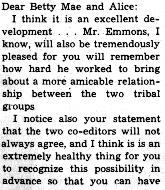
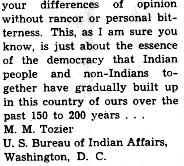
M.M. Tozier, U.S. Bureau of Indian Affairs,
Washington, D.C.
"Dear Betty Mae and Alice:
I think it is an excellent development...Mr. Emmons, I know, will also be tremendously
pleased for you will remember how hard he worked to bring about a more amicable
relationship between the two tribal groups.
I notice also your statement that the two co-editors will not always agree, and I
think is is an extremely healthy thing for you to recognize this possibility in advance so
that you can have your differences of opinion without rancor or personal bitterness.
This, as I am sure you know, is just about the essence the democracy that Indian people
and non-Indians together have gradually built up in this country of ours over the past 150
to 200 years..."
Editor's Note:
"For the benefit of our readers who do not know M. M. Tozier, and
even those who do, we hope you will read about him in this issue's SALUTE TO FRIENDS on
page 4."
Salute to Tozier |
"MIAMI FLORIDA
- Beaming with pride, co-editors, Mrs. Betty Mae Jumper (left) and Alice Osceola look over
the first edition of the Seminole Indian News. Printed in Miami, it is the
first and only newspaper to be published by Florida Seminoles."
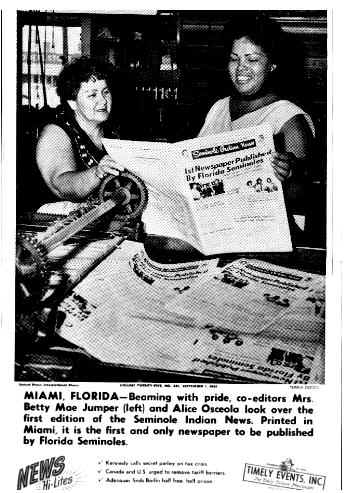
United Press International Photo,
Vol. twenty-five,
No. 261, September 1, 1961 Co-editors Mrs. Betty Mae Jumper (left) and Alice
Osceola
About
The Editors
SEMINOLES PRINT IT
Reported by the Miami News
August 12,
1961, 4B
(Retyped for Clarity)
The Seminole Indians of Florida have gone in the newspaper business - and their
paper looks just about like anybody else's.
ITS MODERN
A modern-looking, four page edition of the Seminole Indian News came out
yesterday with:
A picture of sixteen-year-old Josephine Huff being crowned beauty queen of the
Seminoles; an advertisement urging tribal members to, "Get Out and Vote In The Aug.
14 Election"; a society notice about Guy R. Osceola receiving a 1960 Chevy
Impala from his parents when graduated from Everglades High School and a gossip column
tidbit about how "Elaine Johnson of Immokalee is writing to boy friend, Sammy up in
North Carolina."
There also was a large ad from Dade County and the City of the Miami welcoming
the new publication, a Seminole vocabulary, and Indian history lesson and personal items
from reservations.
A FREE PRESS
In a front-page story, co-editors Alice Joy Osceola and Betty Mae Jumper wrote
that the paper will be a "free press of a free people" and will tell "what
Seminoles are doing and what other people are doing to Seminoles."
Mrs. Jumper, a Muskogee Indian educated at Cherokee, N.C., is a Broward County
visiting teacher for the Dania Reservation and has four children. Miss Osceola will
be a senior at Southwest High and will be the first Miccosukee ever to graduate from
public high school.
The papers, 5,000 of them, will be distributed among the Indians, and sold at 10
cents a copy in tourist shops.
Reported in
the book,
"The Hell With Politics"
(Scanned Image Archive)
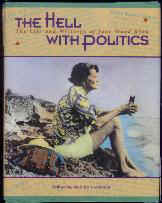
"The Hell With Politics,"
The life and Writings of Jane Wood Reno, Attorney General Janet Reno's mother
pp. 105, 106, 107 and 108.
(Reprinted by permission of author's representative)
p. 105
When The World Gets Old
In your file there are three issues of a newspaper
called the Seminole Indian News published in August, September, and October of 1961.
What were the origins of this paper? Did you have something to do with this,
and is it still being published?
Best paper I ever wrote for! I loved it. This is the way it happened.
In the late forties, Indians on the reservations of Florida organized to sue the U.
S. Government. I believe it was in 1948 that the government passed a bill that
allowed Indian tribes to sue them under violated treaties. Well, if there were any
treaties ever more violated than the Indian treaties of Florida, they're just sections I'm
not familiar with.
So, the Indians along the Tamiami Trail organized in the fifties as the Miccosukee Tribe
of Seminole Indians, for the purpose of suing, and they got themselves a lawyer named
Morton Silver. I got entranced - clear violations, what they were asking was not
unreasonable, as I said, I believe, sixty thousand acres north of Tamiami Trail
to be held in perpetuity and no tribal member would own it. It would be owned
by the tribe, and it could never be alienated from the tribe. And so, these
are bright and sophisticated guys, even though they don't read, and Morton Silver, their
lawyer, was great, and they set out to embarrass the U.S. Government. And I
assisted in that.
Now this was right after John F. Kennedy...
Now, wait a minute. We embarrassed them throughout the 1950s, too. We
went to - they went before I got there, I wish I'd been there - the United
p. 106
Nations. Buffalo presented the United Nations with a buckskin declaration.
Who organized that, and when was that?
That was circa 1951 or 1952. I got in on the act in '53 and they went up to speak to
the U.S. Government. The Miami News sent me along as a reporter, well
really, that was interesting too. But it was public relations, and it was a pitch
designed to embarrass the U.S. Government into straightening up and flying right.
The nearest we came to success was under Leroy Collins. He came down
and met with the Indians, and they came darn near to setting aside this sixty thousand
acres that the Miccosukees of the Trail wanted. Except they wouldn't do it in
perpetuity. They would do it du voir, thirty year, ninety year, I don't
remember what.
But the state technically had the power?
Oh, yeah, it was state-owned land. They almost did it, but the Indians said,
no, no term on it, it must be forever. And all ours. But Leroy came nearst
doing it, and the Indians liked him. One of the most fascinating things I ever saw -
Millard Calldwell was associated with Morton Silver and the Miccosukees in their land
claim, obviously for his potency because he was a former governor of Florida, a
long-legged man, with all that Southern long-legged authority, and he came out there and
gave them a pitch some time in the 1950s that they should join the Indians of the
reservation in their money claim.
Those old Indians got up and talked, and talked to him through Buffalo Tiger, their
spokesman. They said no, and they shamed that man, and he walked - that long-legged,
arrogant ex-governor of Florida walked - down the aisle in shame. Because he had
suggested, in effect, that they sell out.
What actually did you have to do with the paper, since your name appears nowhere
in it?
It's well known that the rewrite man's name doesn't appear. But this paper was
purely designed to embarrass the U.S. Government. It was the last gasp of the
Miccosukees - Kennedy has just been elected - and it was before they dropped their land
claim and decided to join the money claim. And so, Betty Mae Jumper was the editor
from the reservation. Betty Mae is now the chairman of the council. A lot of
city people call her the "lady Indian chief" or something like that, but she's
the chairman of the council of the Dania reservation, and of the Seminole Tribe.
Alice Osceola was the other editor. The two lady editors met on my
porch.
p. 107
the editorial board consisted of Alice's five brothers, and the whole editorial
board had to bring her a six-pack of beer apiece, and they would tell me what they wanted
to say, and I would turn around and put it in my typewriter and read it back to them then
and there. So we had a lot of fun. May I say that my great and good friend
Morton Silver made it up and laid it out. He was a fascinating person, too.
This is as good as a time as any to talk about Morton Silver.
Once upon a time I was out at the Green Corn Dance about
three o'clock in the morning with my daughter Janet Reno, a lovely long-legged girl.
At the Green Corn Dance you're not allowed to eat, but you drink. So I
said to Homer Osceola - Morton, and Janny, and I were there - I said:
"Homer, some day Morton will die as all men must and you're still
gonna have an Indian land claim going on, and my daughter Janny Baby, who's a Harvard Law
School student, can take it over."
And Homer looked at Janny and said:
"Janny Baby, you will never make a good Indian lawyer, because you're too
beautiful and too young, and you will want to be popular. Morton Silver's a Jew and
he doesn't care whether he's popular or not and he makes a great Indian lawyer."
Where does Morton Silver practice law?
He practices law in Miami. I think Buffalo Tiger has
come to him for a divorce or something. When I first met him everybody was saying
"Eeennh! This Jew lawyer, he's trying to get in on those land claims and make
all that money." His family remembers it and the Indians remember it as the
time Morton was wasting all his time and not making much money at all on Indian claims.
He got really roughed up. He was a crusader, And I thought to a
certain extent Homer might have been right, because he was Jewish - which is a minority -
and then I realized another thing. Morton had fallen out of a window when he was a
boy and had to lay in bed for about a year and was crippled and had to have several
operations. He was not only a Jew but he was a crippled Jew, and he was on the
side of every Indian in that swamp. He wasted more time and a great deal of money,
and Indians knew it. They knew it.
Now that the Indians have dropped their land claim, Morton
is making quite a decent living for his six children.
p. 108
The term Seminole is misleading. What does it really mean?
Well, you hear it, most books say it's "run away."
But I asked Howard Osceola once: "What does Seminole Mean?"
And he said:
"Well, my daddy told me that back yonder when they were
chasing them all, when they were chasing all the Indians, some white soldiers said to one
of our fellas, one of the Miccosukees, "Who are those Indians we see out there way
away, out on the horizon? We can never catch up with them, the ones that are always
running away, Who are they?"
"And our fellow said 'Seminolay!' It's a word of our
language, the Miccosukee language, that means wild, a seminolay pig, a seminolay horse,
wild, not fenced in, feral. It really doesn't mean run away, it means a wild hog, a
wild horse - a free man!"
There are some distinctions, aren't there, between Muskogee Seminoles and
Miccosukee?
That's kind of fascinating. There are remnants of two
Indian tribes here now, Miccosukee and Muskogee, and they speak two different languages.
But not too long ago Howard Osceola said to me, "Jane, you know, there
are still some Spanish Indians in the Everglades."
And I said, "Really?" You know, the Spanish
Indians, the ones we read about in history, are Calusa.
And Howard said:
"They say there are some still out there - of course this is historical
legend - that don't speak any language we know. I've never seen one but my mother
and daddy did. And there are supposed to be some living out there on the
hammock."
But originally the Indians of south Florida had nothing to
do with anything called Seminole, They were Calusas - Spanish Indians. At
least it's a legend with people who are my contemporaries, a little young. But,
these guys, they came down, they were two separate and distinct tribes. The
Muskogees were Creeks, and the Miccosukees were initially found around north Florida, in
the Panhandle north of Tallahassee. And they were pushed down and down and down, and
they speak quite a different language. Their language is, their words are, not the
same. They have no written language. Any written language they have is
somebody's interpretation.
They're different in background entirely. When the Muskogees have a Green Corn
Dance, they have to go up to Brighton and practically kidnap...
|